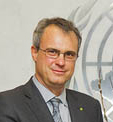 By Eduardo Rojas-Briales, Commissioner-General for United Nations participation in Expo 2015, Assistant Director-General, FAO Forestry and UN-REDD Programme Strategic Group member
By Eduardo Rojas-Briales, Commissioner-General for United Nations participation in Expo 2015, Assistant Director-General, FAO Forestry and UN-REDD Programme Strategic Group member
The road from Rio+20 The United Nations Conference on Sustainable Development Rio+20 summit, held in 2012, reaffirmed that food-related issues are among the most critical that humans face and must seriously address. Expo 2015 has explicitly acknowledged this by selecting the theme, Feeding the Planet, Energy for Life. The theme also aligns fully with the United Nations’ focus on food security, nutrition, sustainable development and climate change.
The current discourse on food and a lasting Expo legacy
For six months, Expo 2015 will be at the heart of the public global discourse on food, with visually impressive exhibits and informative events that present the state of the art of food as well as challenges and opportunities in the future. Expo 2015’s organizers are keen to ensure that its legacy will be far-reaching and long-lasting, with guidance on challenges covering a generation.
The United Nations: a key Expo partner
The United Nations (UN) has been a partner at many past expositions, and traditionally represented at a single UN pavilion. For Expo 2015, it opted, together with the Expo organizers and Italy, the host country, for a different and innovative approach. To render the strong synergies between the EXPO 2015 theme and the UN’s global mission more visible, a new form of design and representation was agreed, resulting in the UN being located not just in one place but present in various exhibits and events throughout the exposition site. The UN is also serving as a global advisor on food security to the host country.
Given Expo 2015’s thematic scope, the Rome-based UN agencies (FAO, the International Fund for Agricultural Development and the World Food Programme) were entrusted with the coordination of the UN common inputs, which comprise many forms:
- The Expo 2015 core basic message, or theme statement, was developed around the principles of the “Zero Hunger Challenge”, UN Secretary-General Ban Ki-moon’s personal vision of a world without hunger and a global call to action, which he launched at Rio+20. The display is prominently visible in Pavilion Zero inside the main entrance to the Expo site.
- Multimedia content provided by UN agencies and showcased in 18 “Spoon” installations has been positioned in several thematic areas and clusters around the Expo site.
- Three United Nations Days are being marked, including the main global celebration of World Environment Day (5 June) and World Food Day (16 October).
- UN guests or keynote speakers will be present at numerous events, and UN staff are designing communication tools and products to promote Expo 2015 in the media and reach people in the rest of the world who will probably not be able to get to Milan.
- Participating actively in the Expo 2015 legacy activities, such as the “best practices” competition, in which the UN has won three of the 18 awards, and supporting the Charter de Milano that will be presented at Expo during the meeting of Ministers for Agriculture from 4–5 June.
Expo, forests, trees and food
So what does all this have to do with forests?
First, let us recall the main conclusions of the 2013 International Conference on Forests for Food Security and Nutrition as well as the key messages of the State of World Forests 2014. These documents remind us that forestry is about people, and not just trees, and describe how forests contribute directly and indirectly, and in manifold ways, to food security. For more than a third of the planet’s citizens, this forest-food connection starts at the most basic level: using firewood to make raw food edible for consumption. And in 2017, forestry’s contribution to food security will again be under the spotlight when a High-level Panel of Experts will present its report on Sustainable Forestry for Food Security and Nutrition to the Committee on World Food Security. FAO Forestry submitted a contribution to the scoping exercise for the report’s preparation.
Second, a large number of the Expo 2015 pavilions have been constructed with raw materials obtained from forests – principally wood and to a lesser extent bamboo. Visitors – physical and remote – will be able to see the many inspiring and novel examples of woodbased construction. This will hopefully encourage reflection on increasing the use of forestsourced raw materials in the construction sector, as part of an expanding “green economy”.
Finally, a number of events and pavilions are highlighting forests’ role in food security, such as that of Austria, where a real forest has been created within the pavilion’s perimeters.
On 25 June, the pavilion will also be the site of a special session on forests and food security, where the presence of Andrä Rupprechter, Austrian Federal Minister of Agriculture, Forestry, Environment and Water Management, Nobel Peace Prize Laureate and Indigenous People’s leader, Rigoberta Menchú, and a leading Austrian chef is foreseen.
I can only encourage you to visit Expo Milano 2015 to enjoy the wealth of perspectives on food that participants, partners and supporters wish to share, and thereby deepen your understanding, knowledge and appreciation of one of the planet’s fundamental gifts to its citizens: food.
Expo 2015 is taking place from 1 May to 31 October 2015 in Milan, Italy. More information on its theme Feeding the Planet, Energy for Life, is viewable here.
This article originally appeared in issue 30 of the FAO Forestry newsletter inFO News.


 FAO Forestry Department RSS feed
FAO Forestry Department RSS feed
Leave a comment
Comments feed for this article